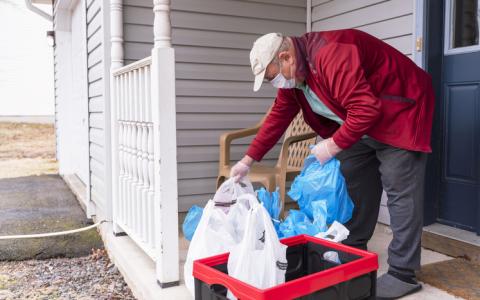Having Food Delivered During the Pandemic? Play It Safe.
Your main risk of contact with the virus would be from the delivery person. Any time you have contact with another person, you should take precautions—for your sake and theirs. Stay at least six feet from the delivery person, and wash your hands with soap and water for 20 seconds afterward. Better yet, take advantage of contactless delivery, paying remotely. (By all means, leave a tip, but do it when ordering, or taped to the door.)
According to the U.S. Food and Drug Administration (FDA), there is no evidence that the virus has been spread in food. What about packaging? The FDA says, “There is no evidence of food packaging being associated with the transmission of COVID-19. However, if you wish, you can wipe down product packaging and allow it to air dry, as an extra precaution.” Some experts suggest disposing of plastic bags and other packing materials before bringing food inside. In any case, sanitize countertops before and after.
Don’t overlook the danger of common foodborne illnesses
We are so focused on the danger of COVD-19 these days that we might not be considering other types of infection that have been with us for a long time. The Centers for Disease Control and Prevention (CDC) says that whether food is shipped to your home or delivered by a local service, it needs to stay at a safe temperature to prevent the growth of germs that cause foodborne illness such as norovirus, salmonella, and listeria — commonly called “food poisoning.”
This is especially important for people who are at higher risk of serious illness from food poisoning, including adults older than 65, children younger than 5, people with health problems, or those who take medications that could compromise their immune system.
The CDC offers these tips:
Arrange for delivery when someone will be home. Items such as meat, seafood, poultry, eggs, or dairy products need to be refrigerated promptly. Let the company know where to leave your delivery. If you can’t bring it in right away, it should be left in a cool, shaded area where pests and rodents can’t get to it.
Learn about the company’s food handling safety standards and procedures. For food that is shipped, make sure the company uses insulated packaging, such as dry ice or frozen gel packs. Find out what you should do if food is delayed or delivered at an unsafe temperature.
Examine the box and packaging right away. Promptly refrigerate or freeze the above perishables mentioned above. Bacteria can multiply rapidly if food is kept in the “danger zone” between 40°F and 140°F for more than two hours.
Promptly check the temperature with a food thermometer. Notify the company if frozen food arrives above 40°F. Don’t eat the food, taste it, or even smell it to see if it is safe. Food can look, taste, and smell OK and still be unsafe. When in doubt, throw it out.
When preparing foods at home, wash your hands and kitchen utensils first. Wash your hands for 20 seconds with soap and water. (That’s a drill we’re all pretty familiar with by now — and it’s important for avoiding foodborne illness, as well!)
Rinse fruits and vegetables under running water. This includes those with skins that are not eaten, such as melons and citrus fruit. Don’t use soap or detergent.
Separate foods to avoid cross-contamination. Keep raw meat, poultry, seafood, and eggs away from other foods. Think of it this way: thorough cooking kills germs in those foods, but if they touched foods you don’t cook, such as produce, they can leave their germs behind. Use a separate cutting board, as well.
Refrigerate leftovers within two hours. See this chart from FoodSafety.gov to learn how long various foods can be safely stored in the fridge.
The FDA also reminds us to regularly clean and sanitize kitchen counters using a commercially available disinfectant product or a DIY sanitizing solution with 5 tablespoons (1/3 cup) of unscented liquid chlorine bleach to 1 gallon of water or 4 teaspoons of bleach per quart of water. WARNING: Do not use this solution or other disinfecting products on food.
